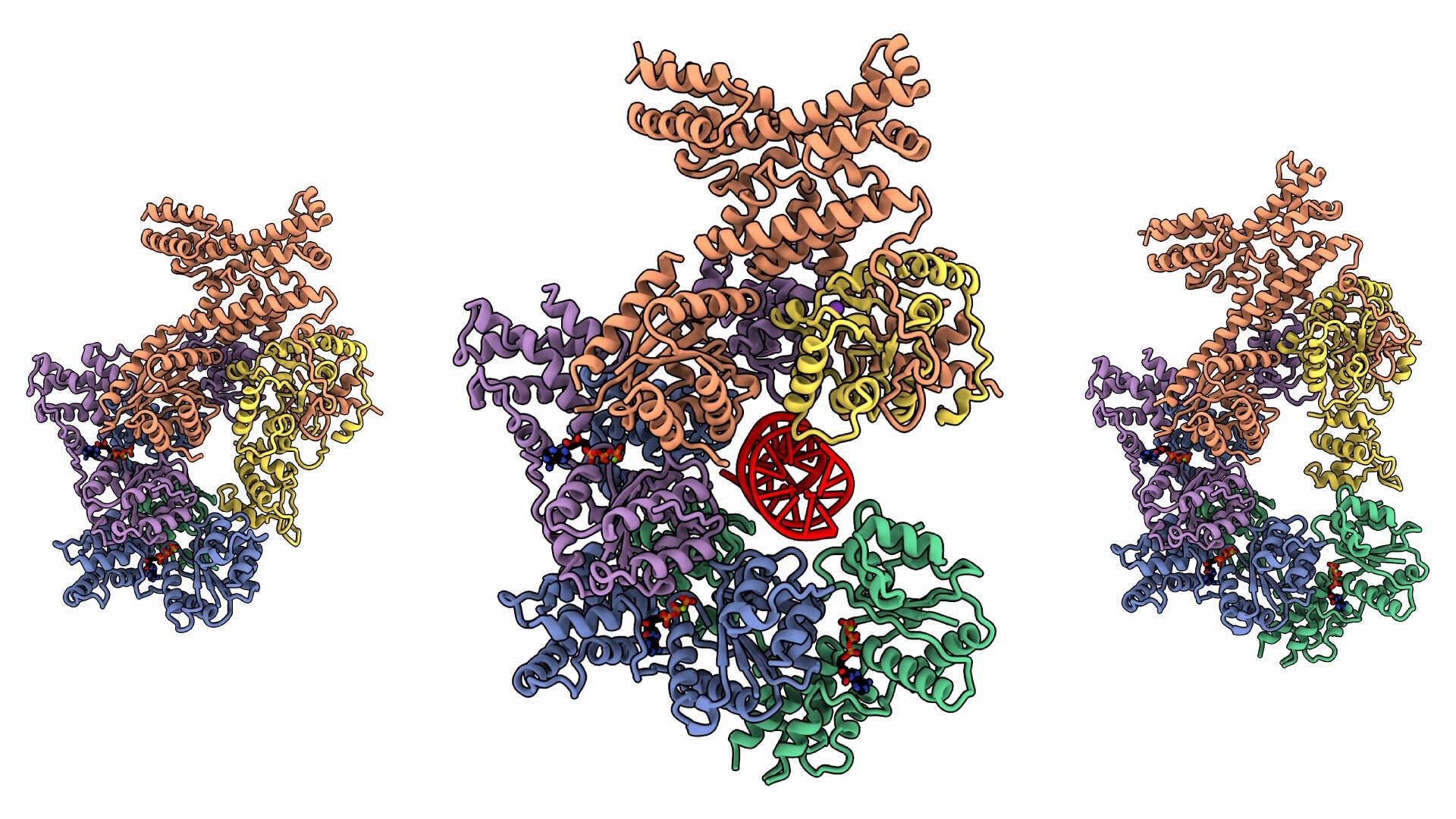The most rudimentary activity of a living thing is to change one copy of its genome into two copies, creating one cell into two. That replication process starts with a series of proteins called the Origin Recognition Complex (ORC).

The Origin Recognition Complex (ORC) is a structure that binds to DNA and starts the genome duplication process as a cell gets ready to divide. In this model of human ORC, the almost donut-shaped complex clamps down on DNA (the twisted helix shown in red in the central model). The model on the left shows the complex covered, protecting the DNA binding cavity. The model on the right shows the complex open, empty of DNA. Image Credit: Joshua-Tor laboratory.
And with certain developmental diseases and cancers connected to ORC proteins, structural biologists need to observe the function of the complex so that they can learn how it might go wrong.
Leemor Joshua-Tor, a Professor at Cold Spring Harbor Laboratory (CSHL) and also an HHMI Investigator, and her collaborators published pictures of the human ORC in exquisite detail in the eLife journal, demonstrating how it modifies shapes in radical ways as it assembles around DNA.
According to the researchers, the initial part of the complex—ORC1—detects the DNA stretch where replication is believed to start and assembles the rest of the ORC (subunits 2–5) at that site.
Although in yeast, a single sequence of peppered all through the genome spells out “start,” there are no such basic signposts for the 30,000 start sites in the human beings. Humans’ initial signals are enigmatic.
When the cell has to duplicate, the first thing that has to happen is that the genome has to duplicate. And so the positioning of ORC on these so-called ‘start’ sites is really the first event that has to happen in order to start the duplication of the genome.”
Leemor Joshua-Tor, Professor and HHMI Investigator, Cold Spring Harbor Laboratory
Joshua-Tor continued, “You know in bacteria, there’s usually one start site because it’s a small genome, but in larger organisms like humans, in order to be able to replicate such a large genome, what the cell does is uses many, many start sites. And the interesting thing in mammalian systems is that we actually don’t understand what a start site really looks like.”
To complicate things even more, when the team looked at different organisms, they identified differently shaped ORCs. However, Joshua-Tor and collaborators found an explanation for such different shapes. Portions of the ORC twist and pinch in radical ways, based on what they are doing at present.
A yeast ORC largely freezes into a single stable shape, and a fly ORC into another shape. Kin On, a CSHL staff scientist stated that, “the yeast complex is so stable, it is rock solid. But the human ORC assembly is very dynamic.”
With the help of sample preparation, cryo-electron microscopy (cryo-EM), and computer analysis methods, the team effectively captured the human enzyme complex in several different shapes, such as one that resembles a fly ORC and another that resembles the yeast ORC.
They arranged a series of pictures into a movie demonstrating a broad range of movements. The team also captured the initial image of a human ORC straddling a DNA molecule, which is crucial for interpreting how the ORCs perform their tasks.
“ORC is flexible, which helps the protein interact with DNA,” stated Matt Jaremko, a postdoctoral fellow in Joshua-Tor’s laboratory.
CSHL President and CEO Bruce Stillman, a collaborator of Joshua-Tor’s on this research, discovered the ORC at CSHL in 1992.
Although a deeper insight into the ORCs may point to more improved treatments for developmental syndromes and cancer, Joshua-Tor believes there is a different reason to learn more about these beautiful cellular machines:
How we duplicate our genome is the most basic process of life, right? Really that’s what life is all about. So, regardless of how we understand cancer and this developmental syndrome, you know, understanding ourselves and understanding the most basic process that is part of the human endeavor really to understand ourselves. So it’s not all about the utility of it. It’s really, y’know, one of the basic endeavors of, of humanity is trying to understand life and ourselves. I think it’s a big part of why we’re doing it. At least a big part of why I’m doing it.”
Leemor Joshua-Tor, Professor and HHMI Investigator, Cold Spring Harbor Laboratory
At the Lab: The "ORC" twists, pinches, and dances around DNA
The Origin Recognition Complex (ORC) is a key piece of cellular machinery, fundamental to life, yet so far mysterious. This video shows the shape of the ORC in 3D with and without DNA. One clip shows how the ORC twists and pinches. ORC2 can swing around the other proteins to cover the cavity where DNA binds. Some shapes can form an energy processing structure; the researchers think that energy is required to shift some subunits into other forms. The scientists speculate that at least some of these movements are critical for the ORC to initiate replication or for it to be ejected from the origin site once the rest of the replication machinery arrives. The images and video clips were made using Cryosparc 2 and UCSF ChimeraX software. Video Credit: Matt Jaremko/CSHL Joshua-Tor lab.
Source:
Journal reference:
Jaremko, M. J., et al. (2020) The dynamic nature of the human origin recognition complex revealed through five cryoEM structures. eLife. doi.org/10.7554/eLife.58622.